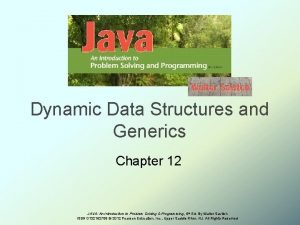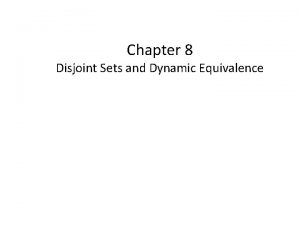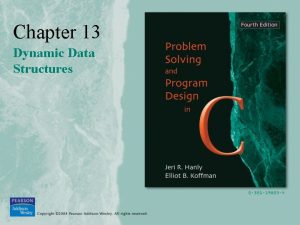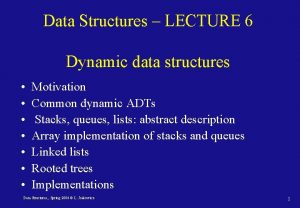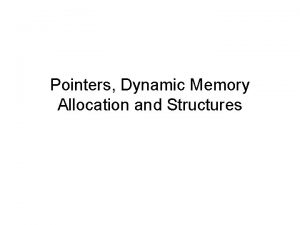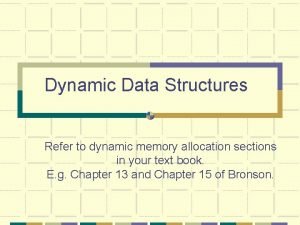Introduction Dynamic data structures Data structures that grow












- Slides: 12

Introduction • Dynamic data structures – Data structures that grow and shrink during execution • Linked lists – Allow insertions and removals anywhere • Stacks – Allow insertions and removals only at top of stack • Queues – Allow insertions at the back and removals from the front • Binary trees – High-speed searching and sorting of data and efficient elimination of duplicate data items 2000 Prentice Hall, Inc. All rights reserved.

Self-Referential Structures • Self-referential structures – Structure that contains a pointer to a structure of the same type – Can be linked together to form useful data structures such as lists, queues, stacks and trees – Terminated with a NULL pointer (0) • Diagram of two self-referential structure objects linked together 15 Data member and pointer 10 NULL pointer (points to nothing) 2000 Prentice Hall, Inc. All rights reserved.

Self-Referential Classes struct node { int data; struct node *next. Ptr; } • next. Ptr – Points to an object of type node – Referred to as a link • Ties one node to another node 2000 Prentice Hall, Inc. All rights reserved.

Dynamic Memory Allocation • Dynamic memory allocation – Obtain and release memory during execution • malloc – Takes number of bytes to allocate • Use sizeof to determine the size of an object – Returns pointer of type void * • A void * pointer may be assigned to any pointer • If no memory available, returns NULL – Example new. Ptr = malloc( sizeof( struct node ) ); • free – Deallocates memory allocated by malloc – Takes a pointer as an argument – free ( new. Ptr ); 2000 Prentice Hall, Inc. All rights reserved.

Linked Lists • Linked list – – Linear collection of self-referential class objects, called nodes Connected by pointer links Accessed via a pointer to the first node of the list Subsequent nodes are accessed via the link-pointer member of the current node – Link pointer in the last node is set to null to mark the list’s end • Use a linked list instead of an array when – You have an unpredictable number of data elements – Your list needs to be sorted quickly 2000 Prentice Hall, Inc. All rights reserved.

Linked Lists • Types of linked lists: – Singly linked list • Begins with a pointer to the first node • Terminates with a null pointer • Only traversed in one direction – Circular, singly linked • Pointer in the last node points back to the first node – Doubly linked list • Two “start pointers” – first element and last element • Each node has a forward pointer and a backward pointer • Allows traversals both forwards and backwards – Circular, doubly linked list • Forward pointer of the last node points to the first node and backward pointer of the first node points to the last node 2000 Prentice Hall, Inc. All rights reserved.

Stacks • Stack – – – New nodes can be added and removed only at the top Similar to a pile of dishes Last-in, first-out (LIFO) Bottom of stack indicated by a link member to NULL Constrained version of a linked list • push – Adds a new node to the top of the stack • pop – Removes a node from the top – Stores the popped value – Returns true if pop was successful 2000 Prentice Hall, Inc. All rights reserved.

Queues • Queue – – Similar to a supermarket checkout line First-in, first-out (FIFO) Nodes are removed only from the head Nodes are inserted only at the tail • Insert and remove operations – Enqueue (insert) and dequeue (remove) 2000 Prentice Hall, Inc. All rights reserved.

Trees • Tree nodes contain two or more links – All other data structures we have discussed only contain one • Binary trees – All nodes contain two links • None, or both of which may be NULL – The root node is the first node in a tree. – Each link in the root node refers to a child – A node with no children is called a leaf node 2000 Prentice Hall, Inc. All rights reserved.

Trees • Diagram of a binary tree 2000 Prentice Hall, Inc. All rights reserved.

Trees • Binary search tree – – Values in left subtree less than parent Values in right subtree greater than parent Facilitates duplicate elimination Fast searches - for a balanced tree, maximum of 2 log n comparisons 47 25 77 11 43 7 17 31 44 65 93 68 2000 Prentice Hall, Inc. All rights reserved.

Trees • Tree traversals: – Inorder traversal – prints the node values in ascending order 1. Traverse the left subtree with an inorder traversal 2. Process the value in the node (i. e. , print the node value) 3. Traverse the right subtree with an inorder traversal – Preorder traversal 1. Process the value in the node 2. Traverse the left subtree with a preorder traversal 3. Traverse the right subtree with a preorder traversal – Postorder traversal 1. Traverse the left subtree with a postorder traversal 2. Traverse the right subtree with a postorder traversal 3. Process the value in the node 2000 Prentice Hall, Inc. All rights reserved.
 Phân độ lown
Phân độ lown Block xoang nhĩ độ 2
Block xoang nhĩ độ 2 Thể thơ truyền thống
Thể thơ truyền thống Thơ thất ngôn tứ tuyệt đường luật
Thơ thất ngôn tứ tuyệt đường luật Chiến lược kinh doanh quốc tế của walmart
Chiến lược kinh doanh quốc tế của walmart Tìm vết của mặt phẳng
Tìm vết của mặt phẳng Con hãy đưa tay khi thấy người vấp ngã
Con hãy đưa tay khi thấy người vấp ngã Tôn thất thuyết là ai
Tôn thất thuyết là ai Gây tê cơ vuông thắt lưng
Gây tê cơ vuông thắt lưng Sau thất bại ở hồ điển triệt
Sau thất bại ở hồ điển triệt Dynamic data structure in java
Dynamic data structure in java Disjoint set adt
Disjoint set adt Dynamic data structures
Dynamic data structures










